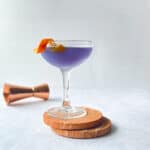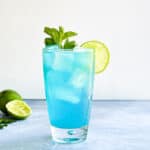Classic Cocktails and Bartending Basics
Are you looking to learn to make classic cocktails and frustrated by promises of Top 10 Cocktails that fail to deliver? Tired of mixologists who boast about easy to make cocktail recipes and in the next breath use obscure ingredients you don’t have at home?
Read on for a simple schematic that shows cocktail families and how the classic cocktails and modern cocktails are related. At the same time you’ll learn some bartending basics, why your ice is more important than glassware, and some tricks for creating your own cocktails from the flavors you love.

Jump to:
Intro
Just like I did with baking and baking ratios and making meatballs and meatloaf, I want to share a helpful framework for classic cocktail ratios. It shows how the classic cocktail families build upon each other to give you infinite variations. That way you can figure out what you love in a mixed drink, tailor these formulas to your own taste, find related cocktails to try, and create cocktails you love without recipes.
Consider this a Cocktails 101 in mixed drinks for beginners. If you already know home bartending basics, consider this a review with suggestions how to take your cocktails at home to the next level. And if you are expert bartender, I’d love if you shared your thoughts in a comment!
Background
During 2022, colleagues encouraged me to start a 52 weeks of cocktails challenge. We explored spirits and liqueurs, classic cocktails, and a variety of other themes. It was eye opening to realize that many cocktails start with one of a few basic formulas.
You can read this post from top to bottom or just skip to your favorite cocktail. No matter what, I hope you’re never at a loss for what to order at a bar or to make from your home bar.
Bartending basics

Shaken vs stirred
The teaching is that cocktails with citrus juices should be shaken to aerate them, and cocktails with only alcohols should be stirred. Shaking results in a larger dilution compared to stirring, and it can make cocktails cloudy.
So James Bond was uncouth to prefer his martini “shaken, not stirred.” Alternatively, it’s a great example of how it doesn’t matter what “they say” if you want to make your cocktails the way you want.
How to shake a cocktail
For the average cocktail drinker and the average cocktail, it doesn’t matter how you shake. If you’re curious, you can read more than you ever wanted to know about shaking your cocktails here.
The dry shake
Despite what I just said, there are cocktails where how you shake does make a difference. Think about the espresso martini or a sour with egg white with their frothy foams. To get that foam, you need to shake longer than normal. But shake with ice and you’ll over-dilute your cocktail and still not get great foam.
A dry shake is when you put your cocktail ingredients in the cocktail shaker without any ice. For best results, shake hard for 20 to 30 seconds. Then add about a half cup of ice cubes, and shake again just to chill.
Just like with the reverse creaming method for cake, you can also do a reverse dry shake. That’s where you first shake your cocktail with ice first, then remove the ice and do a dry shake as the second shake. Do with this information what you will.
Simple syrup
Simple syrups are an easy way to vary the flavor of your favorite classic cocktail. If you can imagine a flavor, you can probably create a simple syrup.
Making simple syrup is really as simple as combining equal amounts of water with sugar, honey, or other sweetener. Get more information here about making simple syrups and how to use them.
Classic cocktail families
Ok, now that we’ve gone through basic bartending knowledge, here’s a basic bartending drinks cheat sheet for how I organize some of the classic cocktails. I apologize in advance if your favorite cocktail isn’t included!
And, also, some ingredients have a range, because your tastes will differ from other people. If you like your cocktails a certain way, feel free to add more simple syrup or citrus or whatever makes you happy.

The cocktails
1. The Martini
Many classic cocktail lists start with the old-fashioned, but the martini is top of the list for me. The classic martini is gin and dry vermouth.

Start with two ounces of London dry gin. You’ll see that many classic cocktails start with two ounces of a spirit. Stir with one ounce dry vermouth over ice and strain.
Or, if you’re uncertain about whether you like a dry martini (one with relatively more gin) or a wet martini (one with relatively more vermouth), try the taste test below. “Dry” generally starts at 2.5 ounces of gin plus half an ounce of vermouth.
Martini Taste Test: Make 1.5 ounce martinis to figure out your preferred ratio.
1. Go very dry by just rinsing your glass with dry vermouth.
2. Dry (5 to 1): 1.25 ounces gin and 0.25 ounce dry vermouth
3. Classic (2 to 1): 1 ounce gin and 0.5 ounce dry vermouth
4. Equal (1 to 1): 1.25 ounces gin and 1.25 ounces dry vermouth
5. Wet (1 to 2): 0.5 ounce gin and 1 ounce dry vermouth
A kitchen scale can help when you’re doing these small volumes. Or know that a half ounce is one tablespoon, and a quarter ounce is a half tablespoon.


I’ll say it again. The best martini is your favorite martini.
You can switch up the gin, or make it with vodka for a vodka martini. Garnish it with olives, a lemon twist, or a cocktail onion. Or add a splash of olive brine if you want a dirty martini.
2. The Old-Fashioned
The Old-Fashioned is another simple classic cocktail. It’s made with two ounces of spirit, a sugar cube or up to an ounce of simple syrup, a few dashes of bitters, and garnished with orange peel or a cherry.
The Old-Fashioned is classically made with whiskey, either bourbon or rye, but you can make an Old-Fashioned using nearly any spirit. Or vary your Old-Fashioned with an infused whiskey, a flavored simple syrup, or some mint leaves for a mint julep.

3. The Manhattan
The Manhattan is the closest sibling of the Old-Fashioned, subbing in sweet vermouth as the sweetener. As a result, the classic Manhattan has two ounces of whiskey, an ounce of sweet vermouth, and dashes of bitters.
Like with the Old-Fashioned, you can vary the Manhattan by changing the base spirit or the sweetener. If you make a Manhattan with dry vermouth, you have a dry Manhattan. If you make it with half an ounce each of dry and sweet vermouth, you have a “perfect” Manhattan. Below are two examples of Manhattan variations:


4. The Negroni
Marry the martini and the Manhattan and you have a Negroni. The Negroni is a classic Italian cocktail that is traditionally made with an ounce of dry gin, sweet vermouth, and Campari.
Campari is a bright red amaro, which means “bitter” in Italian. The amari, like Campari, Aperol, Fernet-Branca, and Amaro Montenegro, are Italian liqueurs with bitter, herbal, and variably sweet flavors.
You can vary the Negroni by switching out the gin or the amaro. Here are a few Negroni variations that don’t stray too far from the classic:


5. The Sour
The sour family of cocktails might be the most important. The sour formula makes easy, classic cocktails that are perfectly balanced between sweet and tart.
The basic formula for the sour is two ounces of spirit, three quarters of an ounce of fresh lemon juice or lime juice or other citrus (plus or minus a quarter ounce), and three quarters of an ounce of simple syrup (plus or minus a quarter ounce). Make it sweeter with more simple syrup or more sour with more citrus juice depending on your preference.
The original sour cocktail did not include egg white, so you can leave it out if you’re concerned about foodborne illness. Or make it with pasteurized egg whites or aquafaba. (If making cocktails leaves you with egg yolks, you can use them in a fruit curd or to brush the crust of a homemade pie.)
Just like with the Old-Fashioned, one way to vary the sour is with a flavored simple syrup. Try this vodka sour with a homemade blackberry syrup.

A change to a different base spirit makes other classic cocktails. Make your sour with rum and lime juice, and you have a daiquiri. Make it with gin and lime juice, and it’s a gimlet. Here are some examples of other cocktails in the sour family:






6. Sour variation with liqueur
Another way to vary the sour formula is to sub in a liqueur for all or part of the simple syrup in the sour. Use tequila and sub an orange liqueur for that simple syrup, and you have a margarita. Use brandy, and you have a sidecar. Here are are some sour variations that use that model, which is sometimes called a daisy cocktail:









7. Sour variation: the highball
You can also take the sour formula, add tonic water or soda water, and serve it over crushed ice for a refreshing summer highball.



8. Sour variation with sparkling wine
Or cut the sour formula in half and top with sparkling wine instead of soda water. Doing this, you can make a French 75 using gin, lemon juice, and simple syrup. Or make your Cosmo sparkle with vodka, orange liqueur, cranberry juice, lime, and sparkling wine like a Prosecco.


9. Espresso Martini
The original espresso martini is a modern cocktail made with vodka, espresso, and coffee liqueur and reads as a variation of a Black Russian. The non-martini Espresso martini had a revival in 2022, gaining popularity with all of its many variations which you can see below.



10. Spritzes and simple mixed drinks
Finally, if you just want a simple mixed drink (or maybe don’t trust your bartender!), you can never go wrong with a spritz made with 2 ounces of liquor, 3 ounces of sparkling wine, and an ounce of carbonated water.
Or ask for a simple spiked drink using 1 part spirit to 2 parts juice or soda or lemonade, etc. The classic example is the screwdriver, made with orange juice and vodka. Just thinking about combining rum and Diet Coke brings back memories.



Cocktail FAQs
The answer depends on what you like to drink. This is the list of what I think are the essential bar tools for making cocktails at home.
Whether it’s beer or wine or liquor, a serving of alcohol has 14 grams (0.6 ounces) of pure alcohol. That’s the amount found in 1.5 ounces of an 80 proof liquor, so many of the cocktails above should be considered two servings.
Everyone is different, but the U.S. recommendation for the average person is no more than two drinks if you are a man or one drink if you are a woman. However, the World Health Organization recently said that no amount of alcohol is truly safe. Please drink responsibly.
Learn more
If this leaves you eager for more, you can always take a bartending course or get a bartending certification if you want to expand out of home bartending.
Join in the 52 weeks of cocktails challenge on Instagram or Facebook.
Bored with the recipes you’ve been cooking and baking lately? Get inspiration here:


This article is a revelation! Thank you for sorting this out in such an elegant way! I’m one of those with a full ingredients cabinet who never knows what to make. You helped me realize I have the ingredients for soooo many things! Will reference this again and again.
Thanks so much, Jennifer. Happy cocktail making!